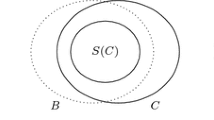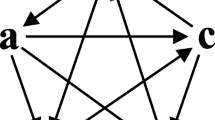Abstract
We define a notion of dynamic (vNM) stable set for a tournament relation. Dynamic stable set satisfies (i) an external direct stability property, and (ii) an internal indirect stability property. Importantly, stability criteria are conditioned on the histories of past play, i.e. the dominance system has memory. Due to the asymmetry of the defining stability criteria, a dynamic stable set is stable both in the direct and in the indirect sense. We characterize a dynamic stable set directly in terms of the underlying tournament relation. A connection to the covering set of Dutta (J Econ Theory 44:63–80, 1988) is established. Using this observation, a dynamic stable set exists. We also show that a maximal implementable outcome set is a version of the ultimate uncovered set.


Similar content being viewed by others
Notes
Harsanyi (1974) points out that the standard stable set fails to take farsightedness appropriately into account since after a blocking the play may revert back to the stable set in a way that is beneficial to the blocking party. Xue (1998) argues that indirect dominance, where the agents block an alternative keeping in mind the outcome that is eventually implemented, is not a satisfactory basis for a stable set either. Nothing prevents an intermediate mover along the dominance sequence from deviating from the plan.
Vartiainen (2013) establishes further connections of the concept of a consistent choice set to models of dynamic decision making.
The result may be sensitive to the details of the underlying model, see Kalandrakis (2004).
Mariotti (1997) is a precursor in this literature, analysing coalition formation in normal form games. To the best of our knowledge, his paper is the first one to formally study history dependence in coalition formation.
For example, if \(R\) reflects the majority rule, then \(x_{k}\) may be challenged with \(y\) by any majority coalition of individuals.
Following Harsanyi (1974), the solution might be called dynamic strict stable set.
For different versions of covering, see Duggan (2013).
Chwe (1994) gives an example where the consistent set is not contained by the uncovered set and, hence, by the ultimate uncovered set.
Due to history dependence, indirect and direct dominance need not coincide.
References
Acemoglu D, Egorov G, Sonin K (2012) Dynamics and Stability of Constitutions, Coalitions, and Clubs. Am Econ Rev 102(4):1446–1476
Anesi V (2006) Committees with farsighted voters: a new interpretation of stable sets. Soc Choice Welf 27:595–610
Anesi V (2010) Noncooperative foundations of stable sets in voting games. Games Econ Behav 70:488–493
Anesi V (2012) A new old solution for weak tournaments. Soc Choice Welf 39:919–930
Anesi V, Seidmann D (2013) Bargaining over an endogenous agenda. Theor Econ 9:445–492
Bernheim D, Slavov S (2009) A solution concept for majority rule in dynamic settings. Rev Econ Stud 76:33–62
Chwe M (1994) Farsighted stability. J Econ Theory 63:299–325
Dutta B (1988) Covering sets and a new Condorcet correspondence. J Econ Theory 44:63–80
Diamantoudi E, Xue L (2007) Coalitions, agreements and efficiency. J Econ Theory 136:105–125
Diermeier D, Fong P (2012) Characterization of the von Neumann–Morgenstern stable set in a non-cooperative model of dynamic policy-making with a persistent agenda setter. Games Econ Behav 76:349–353
Duggan J (2013) Uncovered sets. Soc Choice Welf 41:489–535
Duggan J (2012) Noisy stochastic games. Econometrica 80:2017–2045
Duggan J, Kalandrakis T (2012) Dynamic legislative policy making. J Econ Theory 147:1653–1688
Ehlers L (2007) von Neumann–Morgenstern stable sets in matching problems. J Econ Theory 137:537–547
Fishburn P (1977) Condorcet social choice function. SIAM J Appl Math 33:295–306
Greenberg J (1990) Theory Soc Situat. Cambridge University Press, Cambridge
Harsanyi J (1974) An equilibrium point interpretation of stable sets and a proposed alternative definition. Manag Sci 20:1427–1495
Kalandrakis A (2004) A three-player dynamic majoritarian bargaining game. J Econ Theory 116(2004):294–322
Konishi H, Ray D (2003) Coalition formation as a dynamic process. J Econ Theory 110:1–41
Kultti K, Vartiainen H (2007) Von Neumann–Morgenstern stable sets, discounting, and Nash bargaining. J Econ Theory 137:721–728
Laslier J-F (1997) Tournament solutions and majority voting. Springer, Heidelberg
Mauleon A, Vannetelbosch V, Vergote W (2011) von Neumann–Morgenstern farsightedly stable sets in two-sided matching. Theor Econo 6:499–521
Mariotti M (1997) A model of agreements in strategic form games. J Econ Theory 74:196–217
Miller N (1980) A new solution set to for tournaments and majority voting. Am J Polit Sci 24:68–96
Moulin H (1986) Choosing from a tournament. Soc Choice Welf 3:271–291
Penn M (2008) A distributive N-amendment game with endogenous agenda formation. Public Choice 136:201–213
Ray D (2007) A game theoretic perspective on coalition formation., The Lipsey LecturesOxford University Press, Oxford
Vartiainen H (2013) Endogenous agenda formation processes with the one-deviation property. Theor Econ 9:187–216
Vartiainen H (2011) Dynamic coalitional equilibrium. J Econ Theory 146:672–698
von Neumann J, Morgenstern O (1944) Theory of games and economic behavior. Princeton University Press, Princeton
Xue L (1998) Coalitional stability under perfect foresight. Econ Theory 11:603–627
Acknowledgments
I am grateful for an anonymous referee on comments and suggestions that greatly improved the paper. I also thank Vincent Anesi, Bhaskar Dutta, Klaus Kultti, Hannu Salonen, Daniel Seidmann, Jeroen Swinkels, and Juuso Välim äki for good comments and useful discussions. Financial support from the Academy of Finland is gratefully acknowledged.




